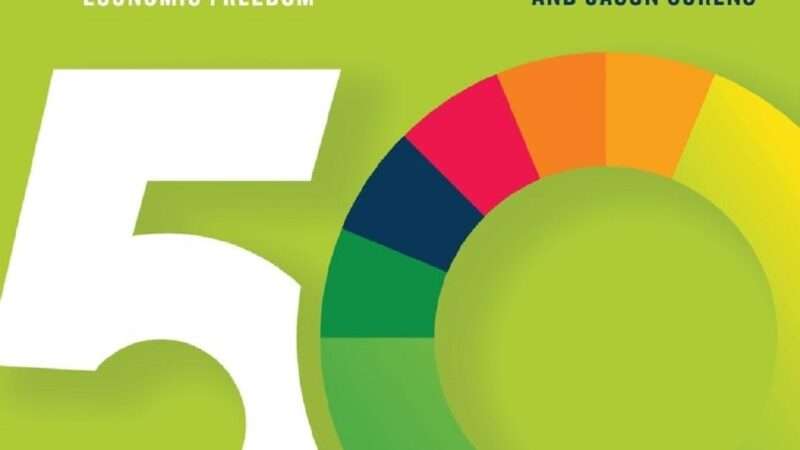

The Cato Institute has recently published the latest edition of the excellent Freedom in the Fifty States, its ranking of state and local policies on economic and personal freedom, authored by political scientists William Ruger and Jason Sorens. Variations in state policy on these issues have major impacts on human freedom and welfare, and also on interstate migration patterns. These rankings are of obvious interest to libertarians; but they are also useful to social scientists and policy analysts with a wide range of views. The book includes a wealth of data on a variety of state policies affecting freedom, as well as overall rankings of state policy, rankings of economic and personal freedom considered separately, and rankings based on a range of subcategories.
Here are the top 10 states, ranked on the combined index of overall freedom (with personal freedom, and two components of economic freedom—fiscal and regulatory) each ranked equally as about 1/3 of the total):
1. New Hampshire 0.71
2. Florida 0.57
3. South Dakota 0.52
4. Nevada 0.51
5. Arizona 0.44
6. Tennessee 0.38
7. Michigan 0.31
8. Missouri 0.30
9. Georgia 0.28
10. Indiana 0.27
The libertarian-leaning purple state of New Hampshire has long ruled these rankings! Several other purple states (Nevada, Arizona, Michigan) also score well. But red states generally do better than blue states, in part because economic freedom variables are about two-thirds of the total score. However, five of the top ten states here voted for Biden in 2020, albeit three of them (Arizona, Michigan, and Georgia) by very small margins.
Blue states do much better on personal freedom, ranked separately:
1. Nevada 0.278
2. Arizona 0.247
3. Maine 0.231
4. New Hampshire 0.204
5. New Mexico 0.198
6. Vermont 0.187
7. Montana 0.147
8. Missouri 0.144
9. Massachusetts 0.138
10. West Virginia 0.128
The top six states here are all blue or purple. But red states Montana, Missouri, and West Virginia still score well. Seven of the top 10 states here voted for Biden in 2020. The bottom of the personal freedom ranking includes many red states, with Texas coming in dead last.
The economic freedom ranking is largely dominated by red and purple states:
1. New Hampshire 0.50
2. Florida 0.48
3. South Dakota 0.43
4. Tennessee 0.35
5. Georgia 0.24
6. Texas 0.24
7. Idaho 0.23
8. Nevada 0.23
9. Wyoming 0.23
10. Michigan 0.22
Four of the top ten states on this list voted for Biden in 2020. But they are all purple states, or perhaps light blue. The bottom of this list is dominated by deep blue states.
The 2023 edition includes a number of new policies and methodological changes, including more extensive inclusion of zoning and other land-use restrictions (an incredibly important set of issues), and state rankings on abortion policy, where great variation has arisen since the Supreme Court overruled Roe v. Wade last year. Because abortion is an issue that divides libertarians among themselves, the authors didn't include it in their main indices. However, the appendices include adjusted rankings that give various types of weights to abortion restrictions, including a pro-life ranking that views them favorably, and two pro-choice versions that give them varying degrees of negative weight.
Not surprisingly, red states look worse and blue states better on the pro-choice ranking models. Because of the fast-moving nature of developments on this issue, the rankings don't pick up some of the most recently enacted abortion restrictions, as they only capture the state of the law as of January 1, 2023.
There is much, much more in this book, including detailed discussions of each individual state, rankings on many specific freedom issues, and more.
Given the nature of the issues at stake, there is plenty of room for disagreement about the authors' choice of policies to focus on, and the relative weights assigned to each. The distinction between "economic" and "personal" freedom is also open to question. To my mind, most economic freedoms also have a personal component (in so far as they enable people to control their lives more fully). For example, private property rights enable people to exercise autonomy, find housing in places where they need it to find professional and educational opportunity, and so on.
"Personal" freedom also often has an economic dimension. Exercising these rights often requires commercial transactions. For example, there would not be much freedom of speech if the government banned payment for its production, or much in the way of abortion rights if the state barred paying medical personnel to perform them.
Despite such caveats, I think the authors generally do a good job of capturing important policy variables, and giving them reasonable weights. Those who disagree with their approach can use the data to assign different weights, or only consider those variables they consider important (e.g.—only economic freedom and not personal freedom, or vice versa).
There are a few policies I would have added, if given the chance. Most notably, "sanctuary city" and "sanctuary state" policies provide undocumented immigrants and those who employ them valuable protection against deportation. The migrants in question could still be detained and deported by federal officials; but the latter often find it difficult to do so without the assistance of much more numerous state and local law enforcement officers. The authors give positive weight to states' willingness to issue drivers' licenses to undocumented immigrants (under their "travel freedom" subcategory of personal freedom), but overlook this even more significant state and local immigration policy.
Despite such caveats, this book is an outstanding resource for anyone interested in freedom, federalism, and the interaction between the two!
NOTE: In addition to my position as a law professor at George Mason University, I am the Simon Chair in Constitutional Studies at Cato. But I have no involvement in the publication of this book.
The post New Edition of "Freedom in the Fifty States" appeared first on Reason.com.







